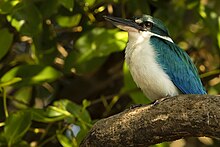Collared kingfisher
| Collared kingfisher | |
|---|---|

| |
| Todiramphus chloris humii Laem Phak Bia, Phetchaburi, Thailand | |
| Scientific classification | |
| Kingdom: | |
| Phylum: | |
| Class: | |
| Order: | |
| Family: | |
| Genus: | |
| Species: | T. chloris
|
| Binomial name | |
| Todiramphus chloris (Boddaert, 1783)
| |
| Synonyms | |
| |
The collared kingfisher (Todiramphus chloris) is a medium-sized kingfisher belonging to the family Halcyonidae, the tree kingfishers. It is also known as the white-collared kingfisher or mangrove kingfisher. It has a wide range extending from the Red Sea across southern Asia to Polynesia. A number of subspecies and subspecies groups have been split from this species including the Pacific kingfisher, the islet kingfisher, the Torresian kingfisher, the Mariana kingfisher, and the Melanesian kingfisher.
Description

The collared kingfisher is 22 to 29 cm (8.7 to 11.4 in) long and weighs 51 to 90 g (1.8 to 3.2 oz). It varies from blue to green above while the underparts can be white or buff. There is a white collar around the neck, giving the birds its name. Some races have a white or buff stripe over the eye while others have a white spot between the eye and bill. There may be a black stripe through the eye. The large bill is black with a pale yellow base to the lower mandible.
Females tend to be greener than the males. Immature birds are duller than the adults with dark scaly markings on the neck and breast.
It has a variety of calls which vary geographically. The most typical call is loud, harsh and metallic and is repeated several times.
Distribution and habitat
It is most commonly found in coastal areas, particularly in mangrove swamps. It also inhabits farmland, open woodland, grassland and gardens. In some parts of its range, especially on islands, it can be seen further inland, ranging into forest or into mountain areas. Birds often perch conspicuously on wires, rocks or bare branches.
The most subspecies that occurs furthest west in the Eurasian/African landmass is T. c. abyssinica of north-east Africa which is found in patches of mangroves in Eritrea and has also been recorded from Sudan and Somalia. Further east in Arabia is the endangered race T. c. kalbaensis with a population of 55 pairs or fewer; these are almost entirely restricted to Khor Kalba in the United Arab Emirates but breeding has also occurred recently at Khor Shinass in Oman. Further subspecies occur locally around the coasts of India and Bangladesh and on the Andaman and Nicobar Islands. In Southeast Asia and Indonesia the species is widespread and common, occurring far inland in some regions.
List of subspecies
There are numerous subspecies in the species’ largely coastal and insular range from the Red Sea to Polynesia:[2]
Red Sea and Arabian coasts
- T. c. abyssinicus (Pelzeln, 1856) – southern Red Sea coasts of Somalia and Arabia
- T. c. kalbaensis (Cowles, 1980) – south Arabian coast
India and Indian Ocean
- T. c. vidali (Sharpe, 1892) – western India from Ratnagiri to Kerala.
- T. c. davisoni (Sharpe, 1892) – Andaman Islands
- T. c. occipitalis Blyth, 1846 – Nicobar Islands
South East Asia
- T. c. humii (Sharpe, 1892) – coasts of West Bengal eastwards to Burma (including the Mergui Archipelago), the Malay Peninsula, Tioman and north-eastern Sumatra.
- T. c. armstrongi (Sharpe, 1892) – interior of Burma and Thailand, Indochina and eastern China
- T. c. laubmannianus (Grote, 1933) – Sumatra and Borneo, including intervening islands.
- T. c. chloropterus (Oberholser, 1919) – islands off western Sumatra
- T. c. azelus (Oberholser, 1919) – Enggano
- T. c. palmeri (Oberholser, 1919) – Java, Bali, Bawean and Kangean Islands
- T. c. collaris (Scopoli, 1786) – Philippines.
Wallacea, New Guinea
- T. c. chloris (Boddaert, 1783) – Talaud and Sangihe Islands through Sulawesi to the Lesser Sundas, West Papuan Islands and north-western New Guinea
Micronesia
- T. c. teraokai (Nagamichi Kuroda, 1915) – Palau
Feeding

Small crabs are the favoured food in coastal regions but a wide variety of other animals are eaten including insects, worms, snails, shrimps, frogs, lizards, small fish and sometimes other small birds as well. The bird perches almost motionless for long periods waiting for prey. When it spots something it glides down to catch it and then flies back to the perch where larger items are pounded against the branch to subdue them. Any indigestible remains are regurgitated as pellets.
Reproduction
The nest is a hole, either a natural tree hole or a burrow excavated by the birds themselves in a rotten tree, termite mound or earth bank. They will also occupy old woodpecker holes. Two to seven rounded whitish eggs are laid directly on the floor of the burrow with no nest material used. Both parents take part in incubating the eggs and feeding the chicks. The young birds leave the nest about 44 days after hatching. Two broods are often raised in a year.
References
- ^ Template:IUCN
- ^ "Collared Kingfisher (Todiramphus chloris)". Internet Bird Collection (HBW 6, p.219). Lynx Editions. Retrieved 2012-06-03.
- Rob Baldwin & Colin Richardson, Mangroves: Arabian sea forests, accessed 11/04/07.
- Heinrich L. Bregulla (1992) Birds of Vanuatu, Anthony Nelson, Oswestry, England.
- C Hilary Fry, Kathie Fry & Alan Harris (1992) Kingfishers, Bee-eaters & Rollers, Christopher Helm (Publishers) Ltd., London.
- Graham Pizzey & Frank Knight (1997) The Graham Pizzey & Frank Knight Field Guide to the Birds of Australia, HarperCollins, London, UK.
- Craig Robson (2002) A Field Guide to the Birds of South-East Asia, New Holland Publishers (UK) Ltd.
External links
- "Collared kingfisher media". Internet Bird Collection.
- Collared kingfisher photo gallery at VIREO (Drexel University)
- Interactive range map of Todiramphus chloris at IUCN Red List maps

